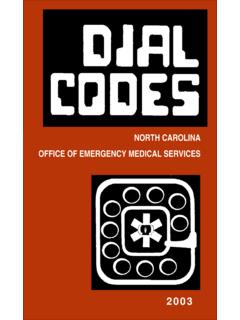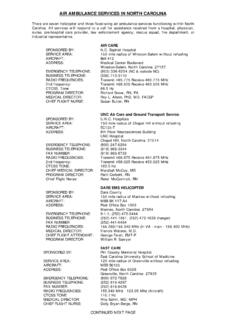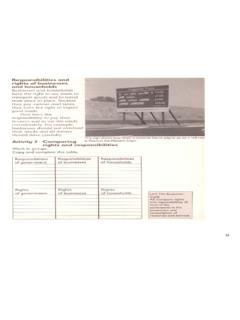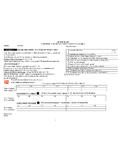Transcription of Instructor’s Course Guide INSTRUCTOR’S LESSON PLANS
1 instructor 's Course Guide instructor 'S LESSON PLANS . Module 1 Preparatory LESSON 1-1 Introduction to emergency medical 1-2. LESSON 1-2 Well-Being of the EMT .. 1-10. LESSON 1-3 medical / Legal and Ethical Issues .. 1-20. LESSON 1-4 The Human Body .. 1-29. LESSON 1-5 Baseline Vital Signs and SAMPLE History .. 1-42. LESSON 1-6 Lifting and Moving 1-51. LESSON 1-7 Evaluation: Preparatory Module .. 1-63. Module 2 Airway/CPR. LESSON 2-1 Airway .. 2-2. LESSON 2-2 CPR .. 2-21. LESSON 2-3 Practical Skills Lab: 2-27. LESSON 2-4 Evaluation: Airway/CPR 2-31. Module 3 Patient Assessment LESSON 3-1 Scene Size-Up .. 3-2. LESSON 3-2 Initial Assessment .. 3-7. LESSON 3-3 Focused History and Physical Exam - 3-15.
2 LESSON 3-4 Focused History and Physical Exam - medical .. 3-23. LESSON 3-5 Detailed Physical 3-29. LESSON 3-6 On-Going Assessment .. 3-37. LESSON 3-7 3-42. LESSON 3-8 Documentation .. 3-52. LESSON 3-9 Practical Lab: Patient Assessment .. 3-60. LESSON 3-10 Evaluation: Patient 3-65. Module 4 medical /Behavioral and Obstetrics/Gynecology LESSON 4-1 General 4-2. LESSON 4-2 Respiratory Emergencies .. 4-8. LESSON 4-3 Cardiac Emergencies .. 4-18. LESSON 4-4 Diabetic Emergencies/Altered Mental 4-35. LESSON 4-5 Allergies .. 4-42. LESSON 4-6 4-50. LESSON 4-7 Environmental 4-58. LESSON 4-8 Behavioral 4-70. LESSON 4-9 4-78. LESSON 4-10 Practical Skills Lab: medical /Behavioral and Obstetrics/Gynecology.
3 4-89. LESSON 4-11 Evaluation: medical /Behavioral and Obstetrics/Gynecology Module .. 4-95. 1. Office of emergency medical services emergency medical Technician Curriculum March 2, 1998. instructor 's Course Guide Module 5 Trauma LESSON 5-1 Bleeding and Shock .. 5-2. LESSON 5-2 Soft Tissue 5-13. LESSON 5-3 Musculoskeletal 5-26. LESSON 5-4 Injuries to the Head and Spine .. 5-34. LESSON 5-5 Practical Lab: 5-50. LESSON 5-6 Evaluation: Trauma .. 5-54. Module 6 Infants and Children LESSON 6-1 Infants and 6-2. LESSON 6-2 Practical Skills Lab: Infants and Children .. 6-20. LESSON 6-3 Evaluation: Infants and Children Module .. 6-24. Module 7 EMS Operations LESSON 7-1 Ambulance 7-2. LESSON 7-2 Gaining Access.
4 7-11. LESSON 7-3 Overviews .. 7-17. LESSON 7-4 Evaluation: EMS Operations 7-24. Module 8 Course Evaluations LESSON 8-1 Module and Final Skills 8-2. LESSON 8-2 Comprehensive Written Final 8-39. Module 9 Clinical Education LESSON 9-1 Clinical 9-2. Appendix A Functional Job Analysis .. A-1. Appendix B Minimum Data B-1. Appendix C North Carolina General Statutes, C-1. Appendix D Forms and Documents .. D-1. Appendix E Enrichment LESSON E-1. Appendix F Remediation F-1. Appendix G Patient Assessment Flow Sheets .. G-1. Appendix H Skill H-1. Appendix I Curriculum Outline .. I-1. 2. Office of emergency medical services emergency medical Technician Curriculum March 2, 1998. instructor 's Course Guide Cardiopulmonary Resuscitation This curriculum contains many of the knowledge and skill objectives of cardio-pulmonary resuscitation.
5 In order to maintain an up-to-date curriculum, the didactic material has not been reproduced. Instructors must utilize the current American Heart Association Guidelines and teaching strategies as the basis for instruction in Module 2: Airway/CPR. Meeting the objectives of this program provides the EMT with the ability to perform CPR; but the program does not contain all of the prevention and recognition material within the guidelines established by the American Heart Association. During the program, if issuance of a CPR card is desirable or required, additional information must be added to the program. Testing and/or other Course requirements for issuance of a specific agency's CPR card will need to be completed within the EMT Educational Program.
6 Requirements for issuing a successful completion card may be obtained from the local CPR training agency. medical Direction Statement medical direction of the EMT is an essential component of prehospital education, and thus is included in this revised EMT curriculum. Physician involvement should be in place for all aspects of EMS educational programs, specifically for every ambulance service/rescue squad. On-line and/or off-line medical direction must be in place to allow for EMT to carry and assist with the administration of medications to patients. Quality improvement is also a required component of EMS education. The role of medical direction is paramount in assuring the provision of highest quality prehospital care.
7 medical Directors should work with individuals and systems to review prehospital cases and strive to achieve a sound method of continuous quality improvement. Curriculum Course Goals This instructor 's Course Guide has been designed and developed to assist the Course coordinator, instructors, and others in planning, managing and teaching the North Carolina emergency medical Technician Curriculum. The goals and objectives of this curriculum are to improve the quality of emergency medical care. 3. Office of emergency medical services emergency medical Technician Curriculum March 2, 1998. instructor 's Course Guide This Course is designed to instruct a student to the level of emergency medical Technician who serves as a vital link in the chain of the health care team.
8 It is recognized that the majority of prehospital emergency medical care will be provided by the EMT. This includes all skills necessary for the individual to provide emergency medical care at a basic life support level with an ambulance service or other specialized service. Specifically, after successful completion of the program, the student will be capable of performing the following functions at the minimum entry level: Recognize the nature and seriousness of the patient's condition or extent of injuries to assess requirements for emergency medical care;. Administer appropriate emergency medical care based on assessment findings of the patient's condition;. Lift, move, position and otherwise handle the patient to minimize discomfort and prevent further injury; and, Perform safely and effectively the expectations of the job description.
9 It is obvious that EMTs provide a service in an environment requiring special skills and knowledge in such areas as communications, transportation, and keeping records. They also serve as liaisons with other emergency services . This Course provides an introduction to these concepts. Individual orientation to the specific systems and services with which the EMT will be affiliated is necessary to achieve a full level of competency. On the following page is the diagram of the educational model. This is a graph representing the flow of the curriculum. The model has the medical and trauma information on either side of patient assessment. The curriculum is designed to have the medical module presented after patient assessment and prior to the trauma module, however, this format may be altered.
10 The entire curriculum is surrounded by continuing education, which is designed to reflect two primary goals. First, during the instruction of the EMT Curriculum, additional continuing education in related content may be provided. Secondly, continuing education is an integral component of any educational process and the EMT should be committed to life-long learning. 4. Office of emergency medical services emergency medical Technician Curriculum March 2, 1998. instructor 's Course Guide DIAGRAM OF EDUCATIONAL MODEL. CONTINUING EDUCATION PREPARATORY CONTINUING EDUCATION. Introduction to emergency medical Care The Well-Being of the EMT. medical / Legal and Ethical Issues The Human Body Baseline Vitals and SAMPLE History Lifting and Moving AIRWAY.













